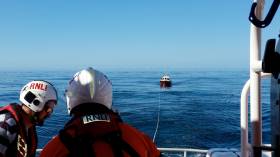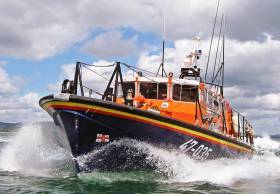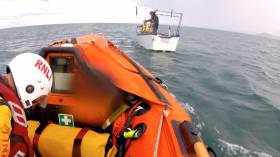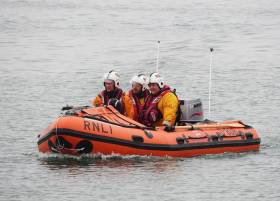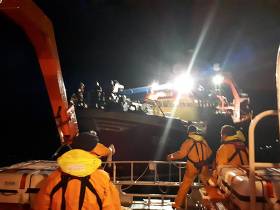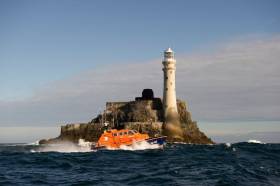Displaying items by tag: Lifeboats
West Cork Lifeboats Launch To Stranded Tug & Angling Boat
#RNLI - Lifeboats from Baltimore and Castletownbere launched two separate callouts off West Cork since Friday (1 September).
Baltimore RNLI was called out yesterday morning (Saturday 2 September) to a tug with three people on board, which had broken down north of Drowlaun Point off Sherkin Island.
The volunteer crew launched their all-weather lifeboat at 9.45am after they were alerted by the skipper of the 12.5m tug. They arrived on scene seven minutes later and quickly established a tow to Baltimore Harbour within an hour.
Conditions at the time were good, with a southerly Force 4-5 wind and a calm sea ahead of the much poorer weather forecast for later in the day.
Elsewhere, Castletownbere RNLI lifeboat was launched on Friday morning to a 30ft angling boat with mechanical failure three miles south-east of Crow Head on the Beara Peninsula.
The lifeboat, under the command of Coxswain Brian O’Driscoll, was launched on service within minutes and proceeded to the casualty some nine miles southwest of Castletownbere Harbour.
The casualty was located in fine weather conditions at 11.07am. RNLI volunteers passed a towrope to the anglers’ onboard and the lifeboat took the vessel under tow to Castletownbere, where it was berthed alongside the pier 90 minutes later.
Wicklow Lifeboat In Search For Overdue Kayakers
#RNLI - Wicklow RNLI’s all-weather lifeboat launched at 8.37pm last night (Monday 28 August) to search for an overdue kayak.
The two kayakers on board were reported overdue to the Irish Coast Guard by a concerned relative after he lost mobile phone contact with them and darkness was falling.
Under the command of coxswain Nick Keogh, the lifeboat was on scene 10 minutes after launching and began a search off Wicklow Head, with the crew quickly locating the kayakers in fading light near the Horseshoe buoy.
The man and woman had earlier left the beach at Ballinacarrig, near Brittas Bay, heading north for Wicklow Harbour. But as they approached Wicklow Head, the tide and current was too strong and they were being pushed back in a southerly direction.
Rescue 116 was also tasked along with a coastguard shore unit from Wicklow. They were stood down once the casualties were located.
The two kayakers were transferred onto the lifeboat and landed safely back at Wicklow Harbour shortly after 9pm, where they were reunited with their relieved family.
Keogh was joined on this callout by mechanic Dean Mulvihill, Ciaran Doyle, Tommy McAulay, David O’Leary and Connie O’Gara.
Three Launches In Three Days For Larne Lifeboats
#RNLI - It was a busy week for the volunteer crew at Larne RNLI last week with three launches for the Co Antrim lifeboats in three days.
On Tuesday 22 August, Larne’s all-weather lifeboat and inshore lifeboat were launched following a request from Belfast Coastguard after a small motor boat was reported overdue, having launched the previous day and making no contact since.
Following further information from Belfast Coastguard, the Larne inshore lifeboat made way to a motor boat north-west of the Number 1 buoy.
On making contact, it was confirmed the crew on board were those reported missing. All were well, with no engine difficulties, and they were able to make their way back to shore.
“It’s essential to have a clear plan when going to sea including checking the weather and tides before you leave and telling someone where you’re going and when you expect to be back,” said Larne RNLI helm Barry Kirkpatrick.
“If vessels do not return at the expected time we would urge members of the public to contact the coastguard by phoning 999 as soon as possible.”
The pagers sounded again on Wednesday 23 August at 6.15pm with reports of a 15ft motor boat with engine difficulties near Ballygally Head.
Larne RNLI’s inshore lifeboat crew were quickly on scene but no motor boat was visible in the Ballygally area. A search commenced and the vessel, with two men on board, was located three miles north-east of Ballygally head.
A tow was established and the boat taken to the safety of Tweeds Port in Carnfunnock.
“The casualty [vessel and crew were] located some distance off shore, unable to make their own way to safety,” said Larne RNLI deputy launching authority Philip Ford-Hutchinson. “We were pleased to see them wearing lifejackets and they made the correct decision in calling for help.
“We would encourage everyone going to sea to ensure your craft is in good condition, always wear a lifejacket and have a means of calling for help.”
On Thursday 24 August, both lifeboats were on exercise in Larne Lough with Mid and East Antrim Mayor Paul Reid and his wife Carol onboard when Belfast Coastguard tasked the all-weather lifeboat on service.
A member of the public reported an overturned vessel with four people on board in Drains Bay.
The lifeboat visitors were returned to shore and the all-weather lifeboat made its way to the scene, where the upturned vessels were found to be sea cadets performing capsize drills. This was a false alarm with good intent.
“This has been a busy week for our volunteer crew who drop everything to answer the call when their pagers sound,” said Larne RNLI coxswain Frank Healy. “Our crews are highly trained and skilled, and excellent team work ensured that all three launches were completed safely and successfully.”
Larne RNLI is currently looking for new volunteer crew members. If you have good general fitness, can work well in a team and have the ability to learn new skills, this role could be for you.
For further information and online application details, see the Larne Lifeboat Facebook page.
Carrybridge Lifeboat Rescues Cruiser From Rocks
#RNLI - Carrybridge RNLI’s lifeboat and rescue water craft were requested on Wednesday afternoon (23 August) to launch to a 30ft cruiser which had encountered fuel issues and drifted onto rocks on Upper Lough Erne.
The casualty vessel, with two persons on board, was located around a mile north of the Crom Estate in Co Fermanagh. The RNLI crew assisted in refloating the vessel and towed it back to Geaglum Jetty.
Elsewhere, Clogherhead RNLI in Co Louth launched on the same afternoon in response to a report that a razor clam fishing boat was sinking off Drogheda Bar.
While the lifeboat was en route to the scene, the two fishing crew were rescued by the Drogheda Pilot Boat, taken upriver and transferred to an ambulance.
The lifeboat travelled at full speed to the scene and on arrival found the casualty vessel almost totally submerged. The RNLI crew managed to locate the boat's EPRIB among the debris.
Lough Derg Lifeboat Assists Six On Grounded Cruiser
#RNLI - Lough Derg RNLI’s inshore lifeboat launched on Monday afternoon (21 August) to assist six people after their 30ft cruiser ran aground behind the Corakeen Islands near Dromineer Bay.
The lifeboat launched on request from Valentia Coast Guard with helm Eleanor Hooker, Ger Egan and Owen Cavanagh on board. Winds were south-westerly Force 3 and visibility was good.
Another motorboat had reported the vessel aground and had dropped anchor close by until the lifeboat arrived on scene.
All six passengers, four adults and two children, were found to be safe and unharmed and wearing their lifejackets.
The lifeboat transferred a crewman over to the casualty vessel, where he reassured everyone on board before he conducted checks of the vessel to ensure it was not holed.
A bridle was then set up in preparation for a tow, and the lifeboat took the boat off the rocks and out into safe water.
Following another assessment, it was found that the cruiser had suffered damage to steering and rudder. The lifeboat then took the cruiser and passengers under tow to the public harbour at Dromineer.
Pat Garland, deputy launching authority at Lough Derg RNLI lifeboat station, reminded boat users to “enjoy the lake but make sure you stay on the navigation route, well clear of the shoreline.”
Wicklow Lifeboat In Medevac For Injured Sailor
#RNLI - Wicklow RNLI’s inshore lifeboat launched yesterday afternoon (Sunday 20 August) to assist Wicklow Ambulance Service with the medevac of a sailor who sustained injuries while sailing in the bay.
The lifeboat crew, comprising helm David O’Leary, Graham Fitzgerald and John Stapleton, transferred the casualty from the yacht at the east pier to the nearby slip, where they were met by a waiting ambulance crew.
Divers Rescued In Dalkey Island Drama
#Rescue - Two divers were rescued yesterday afternoon (Sunday 20 August) after they failed to surface during a dive off Dalkey Island.
The dive boat cox alerted the Irish Coast Guard by marine VHF and began a search patter procedure as Dun Laoghaire Coast Guard’s four search units, Dun Laoghaire RNLI’s all-weather lifeboat and the coastguard helicopter Rescue 116 were all tasked to the scene.
The lifeboat and helicopter backed up the dive boat and coastguard search of the coast from Coliemore Harbour to Killiney Beach, a distance of some 15km.
Within minutes, coastguard members searching off Whiterock spotted the divers being pushed towards the coast with the tide and wind as weather conditions worsened.
All vessels were alerted, and the dive boat recovered the two divers, who were said to be in good spirits despite their ordeal.
In a second callout yesterday, Dun Laoghaire Coast Guard volunteers were tasked to assist a 17ft boat with engine failure being towed to Dun Laoghaire Harbour by lifeboat. All aboard were reported in good condition.
Arranmore Lifeboat On Marathon Rescue Mission For Stricken Trawler
#RNLI - Arranmore RNLI's lifeboat crew responded to their third callout in a week early yesterday (Friday 18 August) to assist a fishing trawler with five people on board which got into difficulty after engine failure.
The fishing vessel, which left Killybegs in the early hours, was not long after stranded 10 miles north-west of Glen Head in Co Donegal. The Arranmore lifeboat launched at 3.30am and reached the casualty vessel at 5am.
Weather conditions at the time were challenging, with a two-metre swell and west south-west winds of Force 5-7.
Having reached the trawler in darkness, the lifeboat managed to get a rope on board to tow the vessel to Killybegs harbour, though progress was hindered as the rope broke several times due to the weight of the vessel and the high sea swell.
After a slow nine-hour tow, the fishing boat was finally safely berthed at Killybegs and the lifeboat returned to base at 6pm, a full 14 hours and 30 minutes after launch.
Arranmore RNLI coxswain Jimmy Early paid tribute to the crew of the fishing vessel.
“They were a very experienced fishing crew and knew exactly what was required to bring them safely ashore. Now it's bedtime, hopefully.”
Baltimore Lifeboat Launches To Boat Aground In Heavy Fog
#RNLI - Baltimore RNLI launched in the early hours of yesterday morning (Thursday 17 August) after a boat ran aground in heavy fog near the West Cork village.
The volunteer lifeboat crew were paged at 00.39am to assist the 50ft vessel with three people on board. Sea conditions in the area were calm, but visibility was poor due to fog.
Under the command of coxswain Kieran Cotter and with mechanic Cathal Cottrell and crew members Pat Collins, Kieran Collins, Don O’Donovan, Jerry Smith and Micheal Cottrell, the lifeboat reached the vessel within 15 minutes.
After assessing the grounded boat’s situation and checking the surrounding area for any navigational hazards, a tow was established and the vessel was pulled clear.
There was no apparent damage to the vessel and no injuries to anyone on board, so it was allowed to move under its own power Baltimore Harbour, where it arrived escorted by the lifeboat at 1.20am.
Speaking following the callout, Baltimore RNLI volunteer lifeboat press officer Kate Callanan said: “With bad weather forecast for the next few days we would remind everyone taking to the sea to respect the water.”
Earlier in the week, Baltimore RNLI launched on Tuesday night (15 August) after reports of a flare sighted at Gokane Point, near Toe Head.
However, the lifeboat was stood down en route when the Irish Coast Guard learned that the flare was actually a firework set off from land and not a boat in distress.
Elsewhere, Arklow RNLI’s volunteers launched yesterday afternoon following a pager alert to a call for help from a sailing vessel with engine trouble.
In moderate seas, the lifeboat Ger Tigchlearr proceeded to the reported position of the casualty vessel, some four miles north east of Arklow Harbour and with two people on board.
Once on scene, the vessel and crew of the casualty vessel were found be in good order, and a towline was established it bring the boat back to Arklow.
John Tyrrell, Arklow RNLI’s lifeboat operations manager, commented: “Our crew were able to get the casualty vessel in a timely fashion. We would like to commend the skipper of the boat for calling for help at an early stage.”
Dunleary Lifeboat Returns To Home Port After 80 Years
#Lifeboats - A lifeboat once stationed in Dun Laoghaire almost a century ago has returned to the harbour thanks to the efforts of a local restoration group.
The Dunleary was secured in the Coal Harbour yesterday (Tuesday 15 August) after transport from Amble in Northumberland, where it had been been dry-docked for many years.
Now the Dunleary Lifeboat Project, whose efforts brought the vessel back to Dun Laoghaire, are gearing up to restore the lifeboat to its former glory — and are calling for donations to cover the costs of transport and storage, as well as support the next vital stages of the project.
RNLB Dunleary was stationed in the South Dublin port from 1919 (when it was still known as Kingstown) till 1937, during a tumultuous and historic time for the island of Ireland.
According to the UK’s National Historic Ships register, the Dunleary launched 81 times in its two decades at its titular port, saving 85 lives.
Following its time in Dublin Bay 80 years ago, the Dunleary moved across the Irish Sea to the RNLI station at Lytham St Annes in Lancashire — where it helped save 28 lives during the Second World War.
Some time after that, the boat was decommissioned and converted into a motor sailer, and in 1970 came into the possession of Jack Belfield and Pat Jopling of Amble, whose plans to restore her as a work/pleasure boat were not to be.
After her husband Jack’s death, Pat Jopling kept the Dunleary in the boatyard she owns, though in 2014 its future was rendered uncertain due to a planned redevelopment.
Previous moves to relocate the boat to Lytham fell through, but that allowed Brian Comerford and the Dunleary Lifeboat Project to step in and negotiate her return to the port she served almost 100 years ago.
How that the Dunleary is back in Dun Laoghaire, the most pressing concern is securing with the assistance of the Dun Laoghaire Harbour Company of a suitable premises where the restoration work can begin.
For more see the Dunleary Lifeboat Project website, and check the group’s Facebook page for the latest updates.


























